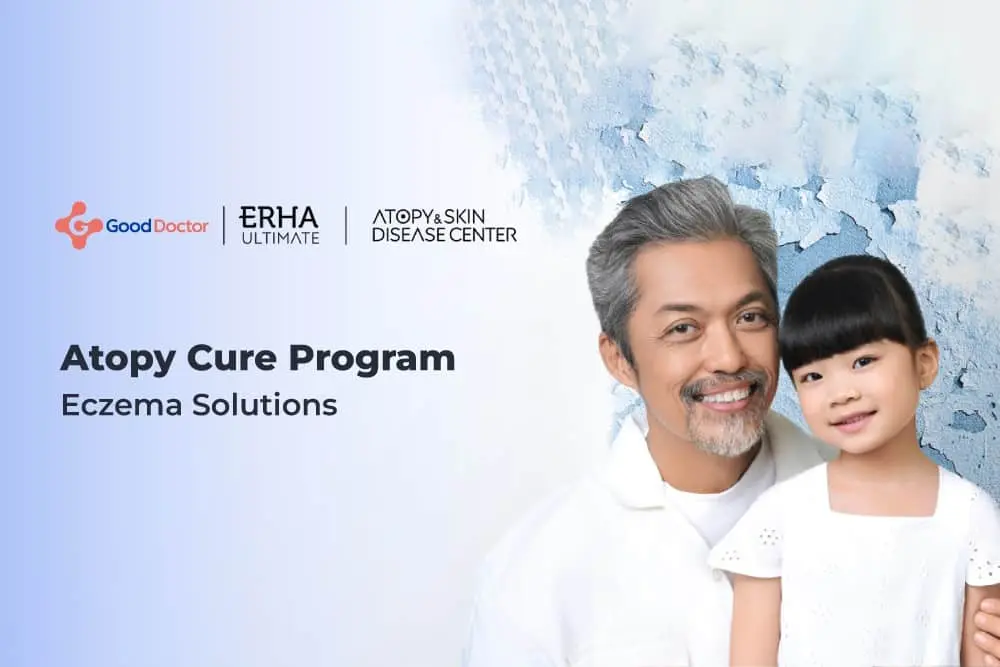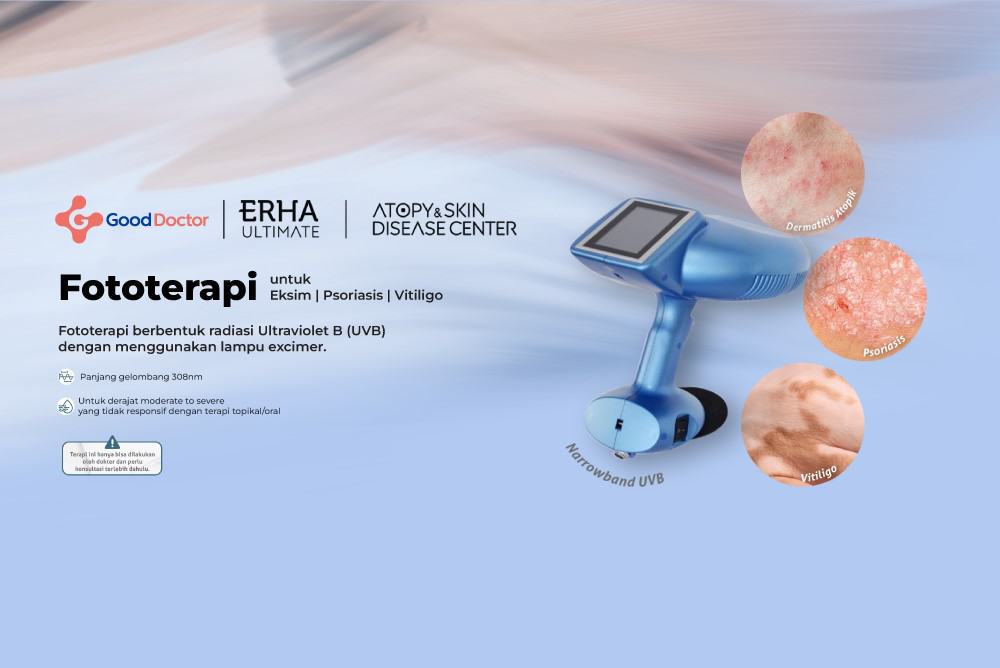Skin is the body’s largest organ and its existence covers the entire outer surface of the body. As the body’s external protection system, the skin is very susceptible to various health problems, including vitiligo. What’s that vitiligo and the cause?
You will find answers about what vitiligo is and its causes in this article, as well as explanations of a number of common skin diseases.
As the body’s first protection, the skin is at risk of experiencing health problems
The skin consists of three layers, namely the epidermis, dermis, and hypodermis, all three of which have very varied functions. However, in general, the skin is an organ that functions as the front guard to protect the body from pathogens, UV rays, chemicals and mechanical injury. The skin also regulates temperature and the amount of water the body releases into the environment.
The presence of skin, namely on the outermost part of the body, makes this organ very at risk of experiencing health problems, namely:
- Allergies, such as contact dermatitis and rashes due to plant toxins
- Trauma or direct injury to the skin
- Insect bites
- Skin cancer, including melanoma
- Skin infections such as cellulitis
- Skin rash and dry skin
- Skin disorders such as acne, eczema, psoriasis and vitiligo
- Skin lesions such as moles, freckles and warts
- Blisters or burns (including sunburn) and scars.
What is Vitiligo and its causes?
Vitiligo is a condition where the skin loses color (pigment) resulting in spots. Can occur on the skin around the eyes, inside the mouth and scalp.
The characteristics of vitiligo are that it is permanent or lifelong, more sensitive to sunlight, the spots are very bright and will be clearly visible in people with dark or brownish skin, it spreads slowly and over a long time, which can take weeks, months or even years.
This skin disorder is not contagious, not dangerous and does not fall into the category of skin cancer or infection. A person with vitiligo is as healthy as a person without vitiligo.
The cause of vitiligo itself is not yet known for certain, but a number of factors are thought to be the trigger, such as:
- Autoimmune disorders, where the body’s immune system actually attacks melanocytes, pigment-forming cells
- Hereditary factors, more than 30 percent of children with vitiligo come from parents who also have the same condition
- External factors such as sun exposure.
After understanding what vitiligo is and its causes, you also need to know that vitiligo has several types, such as:
1.Vitiligo non-segmental
Features:
- The patches have a semi-symmetrical pattern
- The spread is slow
- Appears in groups in only one area
- Spots appear on areas frequently exposed to sunlight such as the neck, face and hands.
However, it can also appear in the areas of the knees, elbows, mouth, armpits, groin, genitals and navel.
2.Vitiligo segmental
Features:
- The spotting pattern tends to be asymmetrical
- The spread is faster
- Tends to appear on areas of skin attached to nerves connected to the dorsal roots of the spine
- Can be detected in children.
Apart from Vitiligo, these are other common skin health problems that attack the skin
1.Psoriasis
Skin disorders in the form of reddish spots and cause itching and pain. Often appears on the elbows, knees and scalp. The appearance of psoriasis is caused by the sufferer’s skin regeneration process being too fast.
If normally the regeneration process takes place within 30 days, psoriasis sufferers only need a matter of days to regenerate their skin. As a result, there is a buildup of skin which causes reddish spots to appear covered by a layer of thick, white, scaly skin. This layer has the potential to crack and cause bleeding.
What causes psoriasis?
There are two main factors that can drive the risk of psoriasis, namely:
- Genetic factors
If you have a family member with a history of psoriasis, you have a greater chance of having the disease.
- Immune system disorders (autoimmune)
Where the body’s immune system actually attacks itself. Normally, white blood cells will attack bacteria that enter the body to prevent infection.
However, in psoriasis sufferers, white blood begins to attack skin cells because it considers it an infection. As a result, skin regeneration runs 10 times faster than normal people, causing plaque.
3.Other trigger factors such as: hormonal changes, alcohol consumption, smoking, and stress.
2. Atopic dermatitis (dry eczema)
Atopic dermatitis is a chronic skin disorder in the form of dry skin accompanied by itching. It is called chronic because it appears repeatedly and gets worse at certain periods.
In children and babies, the appearance of atopic dermatitis generally causes symptoms such as:
- The skin feels dry, itchy and scaly
- In babies, a skin rash appears on the head or cheeks that resembles bubbles and contains clear fluid
- In children the rash appears in the folds of the elbows, knees, neck and face.
Meanwhile, in adults, the appearance of atopic dermatitis is characterized by a striking difference in skin color, either darker or lighter and is easily irritated.
If left untreated, symptoms will develop into inflammation which results in increased blood flow. This causes the rash and inflammation to become more widespread and infection can even occur.
Causes of atopic dermatitis
Skin has a natural ability to maintain its own moisture. Unfortunately, this ability does not function optimally on skin with certain gene variants. Such as someone who has too many inflammatory cells in their skin, or has a thinner skin barrier than most people.
These two conditions make the skin susceptible to disorders, namely the skin becomes drier, easily loses water content, and the like, so that it is easier for irritants to enter and attack the skin.
The risk factor for the emergence of atopic dermatitis is heredity or family genetics. Where if one parent has a history of this disease, then the child’s chance of suffering from atopic dermatitis is 50 percent. The chances will be greater if both parents have this disease.
Environmental factors and habits also trigger atopic dermatitis. Such as weather that is too hot which triggers excessive sweat production, weather that is too cold, exposure to allergens, the habit of bathing in hot water for long periods, using soap or detergent, scratching, and physical irritation.
3. Warts
A skin disease that Indonesian people often suffer from is warts, which are lumps of skin with a rough texture. Warts grow due to infected skinhuman papillomavirus (HPV).
There are 4 types of warts, namely
- Common warts, which grow on the fingers and toes
- Flat warts, which usually grow on the face, thighs or arms
- Pigmented warts, which commonly grow around the mouth or nose, neck, eyelids and armpits
- Plantar warts, which commonly appear on the soles of the feet.
Even though they are not dangerous, the presence of warts often disrupts one’s appearance and reduces a person’s self-confidence.
Warts can actually disappear by themselves, but it takes a very long time, namely around 1-5 years. This is what makes some people need medical procedures to remove warts quickly and safely.
4. Fungal skin disease (ringworm)
This skin disease is also calledringworm Because the pattern is circular like a worm. Ringworm is caused by a fungal infection, ieTrichophyton, Microsporum, andEpidermophyton. The fungal infection that causes ringworm causes a reddish rash that can spread throughout the body. Ringworm generally appears on the scalp, feet, nails, beard, groin, etc.
The symptoms of ringworm that usually appear are:
- Reddish, itchy, scaly, and prominent plaques appear on certain areas of the skin
- The infected area may show symptoms of blistering and the appearance of pustules
- The infected part of the skin is circular in shape and reddish on the outside
- The circular area is usually more prominent and looks like a patch.
5. Acne
This skin disorder commonly appears on the face, chest and back. Usually this complaint occurs in teenagers who are entering puberty due to hormonal changes that encourage the growth of hair follicles. When a follicle is attached to an oil gland, it will become blocked and cause a blackhead,muzzle (small bumps on the skin), as well as acne.
Apart from blocked hair follicles, another cause of acne is excess oil produced by skin cells (sebum). Oil actually functions to protect the skin, but if the amount is excessive, it will clog the pores.
Over time, clogged pores will enlarge and look like whiteheads. The large amount of dirt that accumulates causes blackheads to turn black. If not treated, the follicles will continue to enlarge and form small lumps which are usually accompanied by layers of skin that also break.
This allows bacteria to enter the inner layers of the skin and irritate it, ultimately causing inflammation which makes acne worse.
Treat Skin Disorders at ERHA Ultimate Atopy & Skin Disease Center
Skin disorders cannot be underestimated because apart from causing pain and discomfort, skin disorders, especially in areas of the body that are easily visible, can reduce self-confidence. Seeking medical treatment is necessary so that skin disorders do not develop into more serious conditions.
One of them is that you can get care and treatment for skin health problems at the ERHA Ultimate Atopy & Skin Disease Center (ERHA ASDC). ERHA ASDC is a clinical program that focuses on treating skin problems such as atopic dermatitis, psoriasis, vitiligo and other skin diseases in Indonesia.
For treatment using3-axis products. NamelyOver The Counter Products (skincare), Compounding (medicine formulated by a doctor) andMedical Treatment. These treatments and products are tailored to each individual’s needs and skin conditions.
Apart from being handled by specialist doctors who are experienced and tailored to each individual’s needs and problems, you will also get a number of benefits if you undergo treatment and treatment at ERHA Atopy and Skin Disease Center. Like high technology based therapy, all products for oral and topical treatment have been clinically tested and BPOM so they are safe to use, and the service is equivalent to hospital standards.(hospital grade service) including hygiene, but more efficient, comfortable and easy.
ERHA Ultimate Atopy & Skin Disease Center wants to increase public awareness of the importance of knowing skin conditions and how to deal with the problem in a sustainable manner, through consultations with dermatologists and a series of treatments with best product. Supported by high-tech tools such as Excimer Light.
#Erha #Skin Disorders #Skin disease #Vitiligo #Vitiligo In Children
Reference:
1.National Library of Medicine, diakses 4 Desember 2023. Anatomy, Skin (Integument), Epidermis
2.Cleveland Clinic, accessed December 4, 2023. Skin.
- Good Doctor Indonesia, accessed December 4 2023. Have similar symptoms, this is the difference between eczema and psoriasis
4.Good Doctor Indonesia, accessed 4 December 2023. Don’t underestimate psoriasis, this skin disease can drive sufferers to suicide.
5.Good Doctor Indonesia, accessed 4 December 2023. Atopic Dermatitis: Recognize the Causes, Symptoms and How to Treat It
6.Good Doctor Indonesia, accessed 4 December 2023. Atopic Dermatitis: Recognize the Causes, Symptoms and How to Treat It
7.Good Doctor Indonesia, accessed 4 December 2023. Dry Eczema
8.Good Doctor Indonesia, accessed 4 December 2023. World Vitiligo Day: Recognize the Difference in Children and Adults
9.Good Doctor Indonesia, accessed 4 December 2023. 7 Skin Diseases that Indonesians Often Suffer, Which Have You Experienced?
10.Good Doctor Indonesia, accessed 4 December 2023. Warts Appear on the Body, How to Treat Them?
11.Good Doctor Indonesia, 4 December 2023. Effective and Safe, Here’s How to Get Rid of Acne Properly



